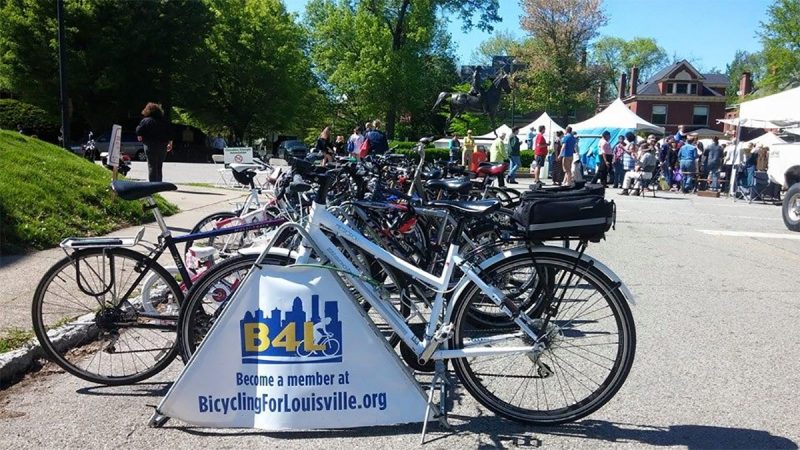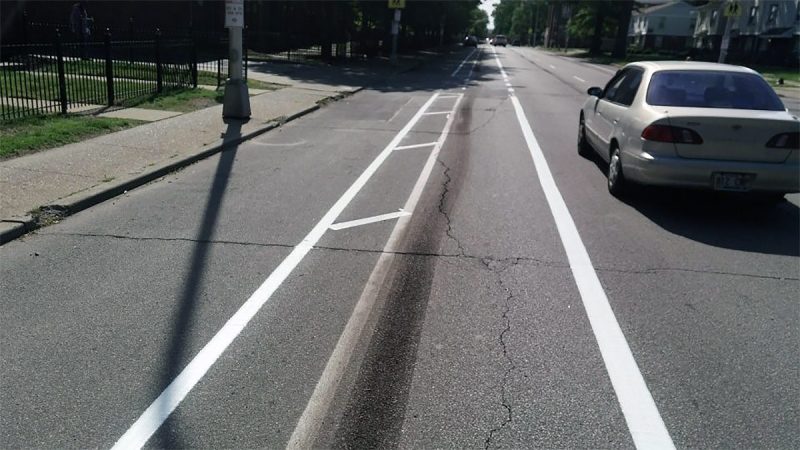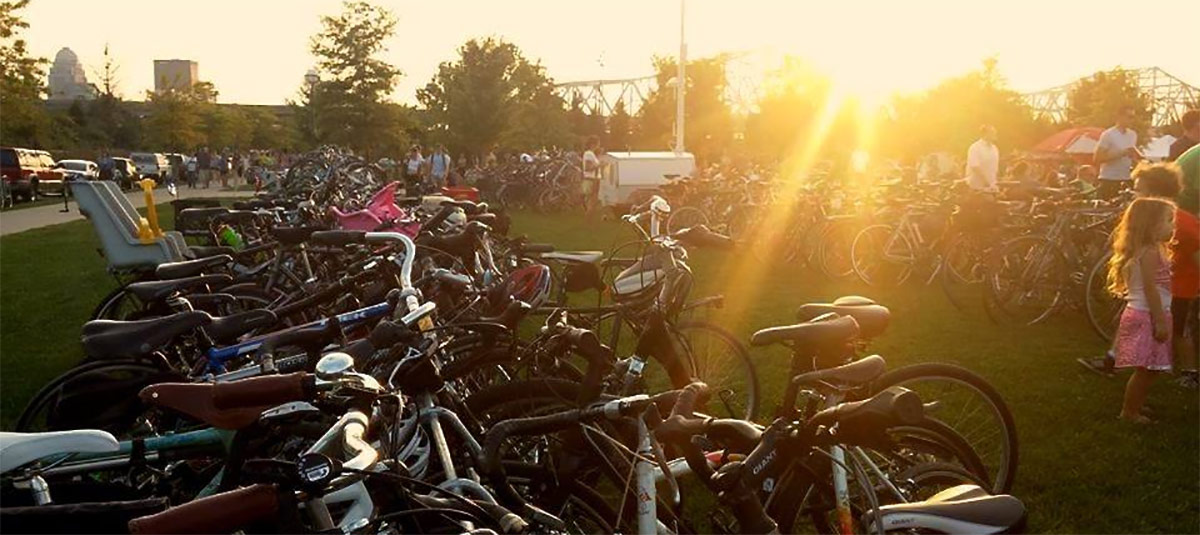Louisville is having a biking moment, and that’s thanks in part to the hard work of Chris Glasser, the president of the nonprofit advocacy group Bicycling for Louisville (B4L). Since moving back to his hometown from Portland, Oregon, in 2013, Glasser has been busy promoting active transportation in Louisville, bringing in a few ideas he’s seen while living in Portland and, before that, Boston. Among those ideas is Louisville’s growing Neighborways system, a network of bike boulevards that is among the reasons Louisville landed this year in the League of American Bicyclists’ Silver ranking for bike friendliness—no small feat.
As we continue along in the #YearOfTheBike, Glasser spoke with Broken Sidewalk editor Branden Klayko about the state of biking in the city today, what’s in store for Louisville’s streets, and the many challenges we still face to improve our streets and increase biking in the community.

Broken Sidewalk: Bicycling for Louisville has grown significantly from its early days as a small organization with a shoestring budget. Once you came on board as president, you helped to increase that budget to take on a larger role in the community. How has B4L grown since you’ve taken the helm and how do you see it evolving from here?
Chris Glasser: We see B4L growing because a lot of our ambition is larger than just bicycling. We’re interested in more than just bike lanes. I don’t really even think of us so much as a biking organization so much as an active streets and urban development organization. We say we’re for healthier lifestyles through active transportation. We’re for environmental stewardship. We’re for spending less on your car so more of your money can stay in the local economy. We’re for all these different things—that’s the scale of our ambition.
And there’s a small but real community of people in town who see this mission and respond to it. Our membership has grown by 10 to 12 times what it was in 2013. That said, it can be a tough thing for people to wrap their heads around. Olmsted Parks, Louisville Grows, even the Louisville Bicycle Club, I think those missions are very intuitive for people to understand. For us, explaining that, no, wider roads aren’t safer roads or, no, cyclists actually do pay their fair share for the roads they ride on. These are harder conversations to have.

How do you see bike culture in Louisville right now? Where are we as a city now and how is it changing?
The idea of how we’re doing is a question we get a lot. I would say we’re making progress, we’re making more progress in the city than we’ve ever made at any other point.
What Mayor Fischer has allocated in terms of budget for bike infrastructure goes above and beyond anything that’s ever been spent in this city. That goes for the urban bike network and Louisville Loop and things happening in parks. We’re making, by our own standards, the most progress we’ve ever made.
What are some specifics?
So, this year, the budget allocates $400,000 for bike infrastructure. Over the last three years, that’s $1 million for bike infrastructure.
The thing is, that sounds like a lot. Any time you say the word “million” people get excited, whether they’re for or against bikes. But that’s less than 0.1 percent of Public Works’ total budget over that time. It doesn’t get you very far. And this is where I start to sound like a hater.
Frankly, I see us falling behind nationally. I mean, we put in 2.5 miles of bike lanes in the last 12 months. Every year, the mayor’s budget announcement says something like, “30 more miles of bike lanes!” I mean, that’s wildly inaccurate. We’re not even close to that. In the last year, we put in bike lanes on Muhammad Ali, Chestnut, and Fourth Street. That’s it.

How does that compare to other cities?
The reality is that places like Pittsburgh or Indianapolis are spending a lot more than we are, they’re doing a lot more than we are. We’re not doing badly. But we’re not doing well. We’re not blowing anybody out of the water.
Two things that come to mind in terms of how we stack up. At this point, we don’t have a single cycletrack in the city. By national standards, that’s really quite ridiculous. It’s really disappointing that a road like Lexington Road between Grinstead Drive and Baxter Avenue—that from my perspective is totally ripe for a cycletrack—doesn’t have one. Between Payne Street and Grinstead there’s literally not a single conflict point across the cycletrack, and it leads right into a park! I mean, come on, that should be a no-brainer. In cities like Pittsburgh and Indianapolis, they have already built miles and miles of these separated facilities in their urban areas.
On the other hand, I think our Neighborway system could be really top-notch. Bike lanes on arterials are one thing, but a quiet ride on a low-traffic neighborhood street, that’s the best kind of biking in my opinion. That’s how all of Portland is laid out. People think it’s a mecca for bike lanes, but it’s all about Neighborways. And we’ve got a fully-funded network coming. It’s testing my patience how long it’s taken to get implemented, but it’ll be great.

Louisville just received Silver ranking from the League of American Bicyclists. That’s a pretty big deal for a city like Louisville that’s really just getting started in the bike infrastructure game. What does this designation mean for the city?
I feel like I’m coming off like a hater again, but…I don’t know. I’d guess probably 95 percent of people riding bikes don’t even have any awareness of that ranking. They just want to be safe getting from Point A to Point B. It doesn’t matter if we’re Silver or Bronze or Gold, Shelbyville Road is still a horrible place to bike or walk. And Jefferson Street is still over 60 feet wide with 6 lanes for traffic and people driving 45 mph to catch the next green light. And Oak Street is still a one-way freeway through these urban neighborhoods.
That said, we made a huge, huge, huge gain with the Big Four Bridge. That just has been a game-changer. Downtown Jeffersonville is fantastic. And it’s only going to get better, because that bridge has suddenly made this one part of town more accessible to bike and foot, and people are just loving it.
Is Louisville taking enough political risks to build progressive bike infrastructure? Do we need to do more to keep up with our Silver ranking and other cities?
I don’t think we’re devoting enough resources to the issue. The city’s Bike Louisville department is literally just Rolf Eisinger, and I have been saying for a long time that if we’re serious about our bike infrastructure, we need a better support system for Rolf.
Rolf’s background is in public health. We have no one working on bike infrastructure that’s an engineer. Literally there’s not an engineer in Metro government whose job it is to design bike facilities. That in my mind is one thing that’s holding us back—a lack of human resources working on the problem.
If we could add resources to Bike Louisville, what changes might we see in the city in terms of bike infrastructure?
I think we’d see things speed up. All of the conversations that Rolf and I have or that Bike Louisville is having internally, those wheels would just move faster.
One example is that since last May 2014 we’ve been talking about a bike lane on West Muhammad Ali Boulevard and Chestnut Street, and they only finished those this May. It took a year. The road there is 42 feet wide, which is pretty wide—you didn’t even have to take away a traffic lane, we could just put in a 7-foot bike lane without taking any driving lanes away.
This is something that took months and months to design—and the design was just so slow in coming because they didn’t have an engineer who was capable of creating the design. And this is baffling to me because we already used the 42-foot design on Brook, First, Seventh, Floyd. What was there to think about? It’s literally the same design—copy and paste.
Another challenge is dealing with the state when advocating for new bike infrastructure. Kentucky was just ranked 49th out of 50 by the Bike League for bike friendliness. How do you see the relationship with the Kentucky Transportation Cabinet (KYTC), which controls a lot of arterial streets in the city, and Louisville’s push to be more bike friendly?
So, yeah. There are two kinds of streets in this city—there are city roads and there are state roads. So, Bardstown Road, Third Street, Dixie Highway—those are state roads. Metro government can’t touch them. You’ve written about this, I think, and lots of local folks have pointed this out, KYTC is a huge obstacle, a huge nut to crack. KYTC is great at designing roadways for moving cars really efficiently. What they’re not great at is considering the street for any other user.
My pet example is Main Street at Sixth Street—Main is the state road. It’s six lanes wide, two left turning lanes, three through lanes, and one right turn. This is not a city block made for people. It’s ridiculous that we put up with it. If there’s any consolation, I guess, it’s that they’ve ruined just about every Kentucky city equally—it’s nothing personal against Louisville. They’ve done a particular bang-up job in Frankfort, which, you know, is where their headquarters are. Literally, like, the street their offices are on—it’s just this freeway through an otherwise quiet little downtown.
But as for Louisville, the big roadways—Dixie Highway, Shelbyville Road, you know—if they’re ever going to be people-friendly, we’re going to need KYTC to think in terms of complete streets. I don’t know how or when that is going to happen.
What’s next in Louisville? What projects or initiatives are on your horizon?
So, despite everything I’ve said, I’m optimistic. Metro Councilman Bill Hollander has been really supportive of the Neighborways effort in his district, and we’ve got some great stuff going on in St. Matthew’s this summer. Traffic calming, volume management, that kind of stuff. Hopefully some Neighborways in Audubon and Schnitzelburg as well.
We have a lot of north-south stuff already established but not much going east-west. I’m optimistic about Jefferson Street through downtown. There’s a ton of width. It’s 60 feet or more. It’ll take some money, but mostly it’s just a question of political willpower.
And, well, I’ll throw in a personal favorite I’m pushing for. A cycletrack from Tyler Park down toward Barret Ave. I brought that up last week with Rolf and he didn’t immediately tell me to shove it.



I’d like to see an effort to have open (meaning unlocked) bathrooms in the public parks … I live on a popular biking road and have had several female cyclists stop and ask if they could use my restroom, because there aren’t good, clean places for people to stop along the way. (Shawnee Park is only a short distance down the road, but most of the time, the bathrooms are locked.)